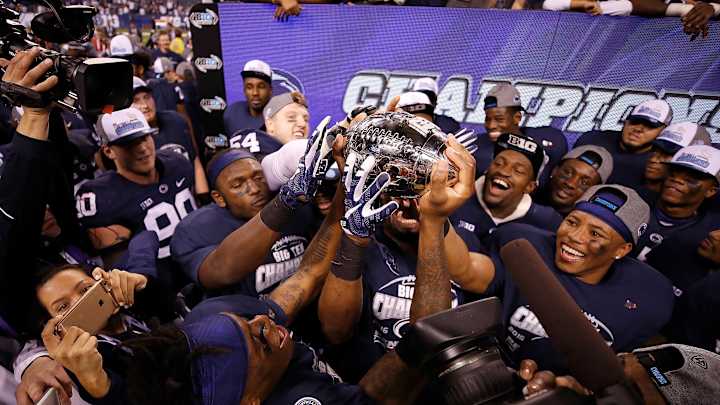It's time to reassess the value of conference championships

The year the Big Ten was founded, in 1896 on a footprint of five contiguous states, William Jennings Bryan gave his Cross of Gold speech and the first-ever automobile speeding ticket was issued.
Sixteen days after the Pacific Coast Conference, which would eventually become the Pac-12, came into being, Woodrow Wilson got married. And nine months before the inception of the SEC, the Lindbergh baby was kidnapped.
On Saturday night, Penn State defeated Wisconsin in the Big Ten championship game, earning itself a conference title and, it thought, a shot at the playoff. After all, it had beaten Ohio State, the only other Big Ten team in real consideration for a spot, head-to-head in October. Plus, Penn State (and Washington, and Clemson) fans repeated en masse, conference titles mean something.
Can Clemson upset Ohio State, return to title game?
And then came Sunday, when the playoff committee’s actions spoke louder than the criteria on its website, which list “conference championships won” first among the evaluation points. Penn State was out, and Ohio State, which met the eye test as the Big Ten’s best but sat at home in Columbus Saturday night, was in for the second time in three years. It was the first time a team that hadn’t won a conference championship was selected into the four-team field. Cue the cries of unfairness, which by the letter of the law seem warranted, but by the spirit, well, I’m sorry, Penn Staters, may not be. The legacy of this season has yet to be settled, but there’s a good chance that in the future, we’ll remember 2016 as the year we realized the concept of a conference championship was if not a farce, then certainly outdated.
The 2016 season kicked off with talk of Big 12 expansion. The country’s weakest conference is also its smallest, with just 10 teams, and after a three-month-long flirtation that should have been hosted by Chris Harrison, Bob Bowlsby and company announced in October that the league would stand pat. The reasons were plenty, but one stood out: dissatisfaction from the television networks over larger payouts should more schools be added. The entire saga hit at a theme that Sunday’s decision solidified: In 2016, conferences are nothing more than television revenue partnerships, and winning one’s title game should factor no more into determining a team’s postseason fate than should any other prominent matchup.
Does Washington have any chance at upsetting Alabama?
Once upon a time, conferences were alliances based on geography and traditional rivalries. There was some sort of natural barometer when teams played round-robin schedules and saw most of their conferences each year. The SEC, which used to span a maximum distance of 750 miles between Kentucky and LSU, now boasts Missouri, which must travel 1,000 miles to Florida. To add to the humor, the two teams are in the same division, the SEC East. Although I suppose it’s understandable to be muddy on the geography of flyover country (I’m kidding, it’s not, the Midwest is amazing and you should learn how it works), here’s a quick lesson: Columbia, Missouri is the third-farthest west city in the SEC. In addition, teams in different SEC divisions face each other only every seven years, except in the case of teams' cross-division rivals.
Consider, too, the Big Ten. When it was founded, it comprised only teams from Illinois, Minnesota, Michigan, Wisconsin and Indiana. Now, 1,300 miles and five rather large states lie between Nebraska and Rutgers. In the Big 12, it takes 1,450 miles as the crow flies to get from Texas Tech to West Virginia, and in the ACC, about 1,300 miles from Miami to Boston College. The Pac-12 seems at least superficially like the most reasonable conglomeration of the bunch, maybe because of the wide open spaces the West calls to mind, but even it, when reduced to numbers, is absurd; Arizona and Arizona State are about 1,500 miles from Washington.
Geographical heresy is just the start, though. Really, this comes down to the money and the fact that schools like Houston, Cincinnati and BYU are willing to jump ship to a Big 12 that was nearly toppled five years ago and has been feeble ever since. The television dollars lie there, though, and it’ll take some major foundational disruption on the business side of the game before that changes, so for the time being, conferences will exist as they stand now. There will be the Power 5, where the money lies, and then the rest, and every other team will claw its way toward the Big 12 the next time it cracks open its doors, no matter how uncertain its face might be. Still, we need to learn to place less value on games because they occurred between conference foes—oh, the storied rivalry that is Rutgers-Indiana—or because they’re deemed a championship game.
Roundtable: Did the College Football Playoff committee get it right?
That’s not to say these title games should disappear, just that they should decline in gravitas. Sometimes, they do decide the best, although among the Power 5 leagues this season, it’s hard to say any but the SEC game did so. The showdown between the two best ACC teams came when Clemson played Louisville, and the true Big Ten title game happened the week before the official one, when Ohio State toppled Michigan in overtime. Washington-Colorado, the actual Pac-12 championship game matchup, has an argument for legitimacy, but the most important game out west may have been played on Nov. 12, when USC beat Washington. The Trojans and Huskies are probably the two best teams in the Pac-12 today, but even so, Washington’s one loss trumped USC’s three, and the true title game results were the determining factor in getting the Huskies into that final four. The best joke of them all, though: The fact that Bedlam functioned as a de facto championship game between the Big 12’s two best teams, on the weekend of the conference championships, in the only Power 5 league without a title game.
That’s all to say that none of this makes a good deal of sense, and we should treat the first weekend in December as such. A championship game is not much more than a chance for schools to get more television revenue and stations to draw in millions more viewers. Divisions are artificial, and if the committee keeps up its current thought process, why shouldn’t Urban Meyer and Nick Saban start scheming complex scenarios whereby their teams earn a so-called extra bye weekend to start their bowl training early?
